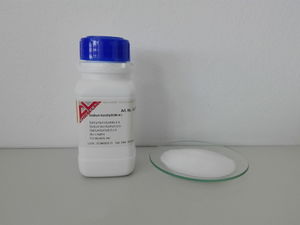Sodium borohydride
 NaBH4 sample
| |
| Names | |
|---|---|
| IUPAC name
Sodium tetrahydridoborate
| |
| Other names
Sodium boranuide
Sodium tetrahydroborate | |
| Properties | |
| NaBH4 | |
| Molar mass | 37.83 g/mol |
| Appearance | White or grayish solid |
| Odor | Odorless |
| Density | 1.0740 g/cm3 |
| Melting point | 400 °C (752 °F; 673 K) |
| Boiling point | 500 °C (932 °F; 773 K) (decomposes) |
| 25 g/100 ml Reacts slowly | |
| Solubility | Reacts with acids, alcohols, aldehydes, carboxylic acids, halocarbons, ketones Soluble in liquid ammonia, amines, isopropylamine, methylamine, pyridine Slightly soluble in DMSO, ethanol, THF, toluene Insoluble in diethyl ether, hexane, pentane |
| Solubility in acetonitrile | 2 g/100 ml (28 °C) |
| Solubility in ammonia | 104 g/100 ml (-33.3 °C) |
| Solubility in diethyl ether | 0.02 g/100 ml |
| Solubility in diglyme | 5.15 g/100 ml 24 g/100 ml (25 °C) |
| Solubility in dimethoxyethane | 0.567488 g/100 ml (25 °C) |
| Vapor pressure | ~0 mmHg |
| Thermochemistry | |
| Std enthalpy of
formation (ΔfH |
190 kJ/mol |
| Hazards | |
| Safety data sheet | Sigma-Aldrich |
| Flash point | 70 °C (158 °F; 343 K) |
| Lethal dose or concentration (LD, LC): | |
| LD50 (Median dose)
|
160 mg/kg (rat, oral) 230 mg/kg (rabbit, dermal) |
| Related compounds | |
| Related compounds
|
Lithium borohydride |
| Except where otherwise noted, data are given for materials in their standard state (at 25 °C [77 °F], 100 kPa). | |
| Infobox references | |
Sodium borohydride, also known as sodium tetrahydridoborate and sodium tetrahydroborate, is an inorganic compound with the chemical formula NaBH4. It is widely used as a reducing agent.
Contents
Properties
Chemical
Sodium borohydride reacts with water to release hydrogen, though the reaction is very slow.
Addition of acids speeds up the decomposing reaction. Boron trioxide has been found to be quite effective, while cobalt(II) chloride as been found to be even more effective.[1]
Sodium borohydride is a strong reducing agent, albeit not as strong as lithium borohydride. It is capable of reducing ketones and aldehydes into their corresponding alcohols. It efficiently reduces acyl chlorides, anhydrides, α-hydroxylactones, thioesters, and imines at room temperature or below. It reduces esters slowly and inefficiently with excess reagent and/or elevated temperatures, while carboxylic acids and amides are not reduced at all. However, in the presence of elemental iodine, NaBH4 has been shown to reduce carboxylic acids to their corresponding alcohols. Tetrahydrofuran is often used as solvent in this case.[2]
Physical
Sodium borohydride is a white solid, which reacts with water and alcohols, though the reaction is fairly slow. Complete decomposition in excess methanol can take nearly 90 min at 20 °C. It will decompose in neutral or acidic aqueous solutions but is stable at pH ~ 14. It has good solubility in amines and poor solubility in ethers.
Availability
Sodium borohydride is sold by chemical suppliers. It can also sometimes be found on eBay and Amazon.
Preparation
Can be prepared by reacting sodium hydride with trimethyl borate, at 250–270 °C:
- B(OCH3)3 + 4 NaH → NaBH4 + 3 NaOCH3
Reaction of boron trifluoride with sodium hydride will give sodium borohydride.[3]
- BF3 + 4 NaH → NaBH4 + 3 NaF
Trimethyl borate can also be replaced with boron trioxide.[4]
Reaction of diborane with sodium amalgam is another route.[5] Using sodium hydride instead of sodium amalgam will also work, with THF or diethylene glycol being used as reaction solvent.[6][7]
Projects
- Make hydrogen
- Reduce organic compounds (reducing agent)
- Fuel cells
Handling
Safety
Sodium borohydride reacts with water to release hydrogen and may be pyrophoric if finely divided. Sodium borohydride itself is very flammable and burns with a bright yellow flame, leaving behind a residue of sodium and boron oxides.[8]
Storage
Sodium borohydride should be kept air-tight containers, away from moisture and air. While it can be stored in most bottles, it will not tolerate prolonged exposure to moisture, so it's best to use an air-tight cap or seal the bottle with parafilm, if you intend on using the borohydride for a long period of time.
Disposal
Can be neutralized safely by adding it in a large volume of water, aq. acids or alcohol. Controlled incineration is also an option.
References
- ↑ https://www.thevespiary.org/rhodium/Rhodium/Vespiary/talk/files/2203-Schlesinger.etal.Sodium.Borohydride.Its.Hydrolysis.and.Its.Use.as.a.Reducing.Agent.and.in.the.Generation.of.Hydrogen0b86.pdf
- ↑ https://pubs.acs.org/doi/abs/10.1021/jo00020a052
- ↑ Hurd, D. T.; Journal of the American Chemical Society; vol. 71; (1949); p. 20 - 22
- ↑ Gaylord, N. G.; Journal of the American Chemical Society; vol. 75; (1953); p. 186 - 190
- ↑ Kasper, J. S.; McCarty, L. V.; Newkirk, A. E.; Journal of the American Chemical Society; vol. 71; (1949); p. 2583
- ↑ Noeth,H.; Beyer,H.; Chemische Berichte; vol. 93; (1960); p. 928 - 938
- ↑ Schlesinger, H. I.; Brown, H. C.; Hoekstra, H. R.; Rapp, L. R.; Journal of the American Chemical Society; vol. 75; (1953); p. 199 - 204
- ↑ https://www.youtube.com/watch?v=OLUKSd5MtR8
Relevant Sciencemadness threads
- Sodium Borohydride
- Sodium Borohydride
- Sodium Borohydride Synthesis
- Borohydride synth?
- Recristallisation of NaBH4
- NaBH4 ester reduction to alcohol ?'s
- Using Sodium borohydride in aqueous media with PTC - stability in water?
- Potassium to Sodium Borohydride
- otc sodium borohyride
- Sodium hydride and borohydride
- Sodium borohydride for sale
- Sodium borohydride in Canada
- Sodium Borohydride from chinese supplier
- Source of Sodium Borohydride
- sodium borohydride to sodium triacetoxyborohydride
- In Search of NaBH4
- Articles containing unverified chemical infoboxes
- Chemical compounds
- Inorganic compounds
- Sodium compounds
- Boron compounds
- Hydrogen compounds
- Metal hydrides
- Borohydrides
- Reducing agents
- Desiccants
- Materials unstable in acidic solution
- Materials that react with water
- Irritants
- Air-sensitive materials
- Pyrophoric materials